BUILDING BRIDGES AND TRESTLES FOR THE CPR
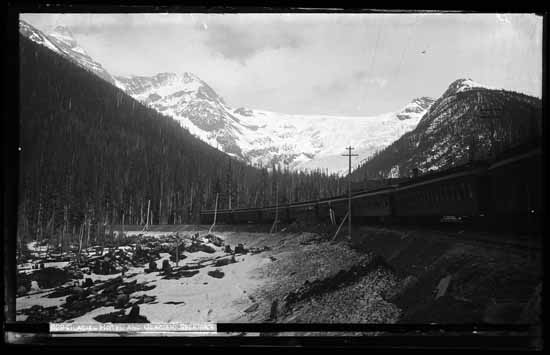
VPL Accession Number: 19994A
Date: 188-
Photographer / Studio: Bailey Bros.
Introduction
When the Steel Went Through by P Turner Bone, relates the stories of the building of the Canadian Pacific Railway, from a first-hand perspective. On the 4th of January 1877, at the age of 17 years, Bone began his five-year apprenticeship with the firm of Kyle, Dennison, and Few, Civil Engineers and Land Surveyors.
After completing his apprenticeship Bone made the decision to move to Canada and with two letters of introduction in hand, his future seemed bright. With his certificate in hand and a small inheritance from his grandmother, Bone set off for Canada.
Bone soon learned how the project worked. He was the head of a camp and determined what each unit of men would do. There were units for falling trees, blasting boulders, and cleaning the debris. Each had to be sent out in a particular order for everything to move properly. A bit like a game of leapfrog. When the unit was finished in a particular section they were sent ahead to the next one.
Upon his arrival Bone wasted no time with his job hunt and within a few days was measuring for new railway lines. The following excerpted paragraphs are from Bone’s book, “When the Steel Went Through,” and they detail his trip down the Kicking Horse River and through to the Second Crossing of the Columbia River.

VPL Accession Number: 31048
Date: 190-
Photographer / Studio: Trueman, Richard H.
Kicking Horse Flats
“My next move was to what was then known as Kicking Horse Flats. There, I had charge of the grading of a section extending about three miles.”
“There were three different contractors doing the work on this section. These were: Dave Isaacs, who had his camp on Porcupine Creek; Quigley and McCrimmon, who had theirs very near my own; and Ole Petersen whose camp was at the farther end of the section, near the site of what is now the station named Leancoil.”
“As contractors and engineers got finished with the work on their particular sections, they moved their outfits to new scenes farther ahead to commence work again on the new contracts.”
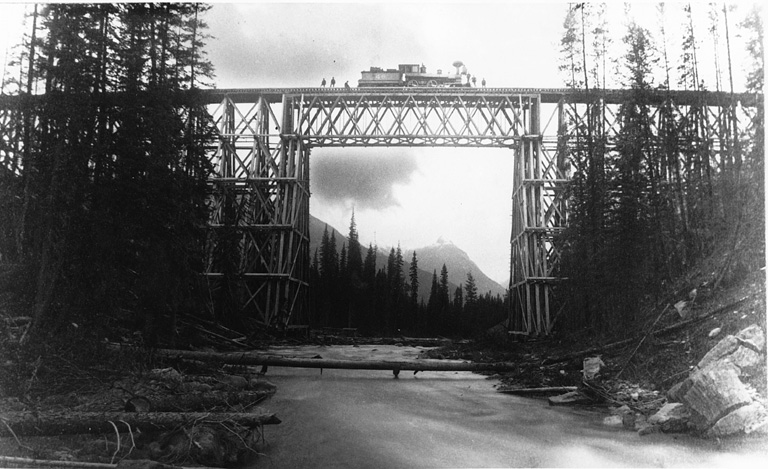
Oliver B. Buell
1885 – MP-1993.6.1.22 – McCord Museum
Ottertail Creek
“The bridge across Ottertail Creek had by this time been completed, and the track was nearing the third crossing. It was a comparatively low bridge extending across the Flats, on what had been Foster’s section near the junction with mine.”
“Plans for the bridges were made by Doane and his assistants in their office at Headquarters. Duggan, who for some time been topographer on Neilson’s locating party, had now joined Doane’s staff; Thomson was still on the job.”
“These bridges might all be classified according to their type; as pile bridges, trestles, and trusses. All were of wood, and, generally speaking, all had pile foundations. Those designated as pile bridges had no superstructure other than caps and stringers. They were usually low bridges.”
Porcupine Creek and the Many Crossings
“As soon as the bridge at the 3rd crossing of the Kicking Horse was finished – and also the small one over Porcupine Creek – I at once moved camp, to keep out of the way of the track-layers.”
“With the bridge at the 4th crossing completed, I had now to give my attention to the one at the 5th crossing. It was a fairly high bridge, and the main part of it was composed of two Howe trusses which were being framed in a yard at the newly established headquarters.”
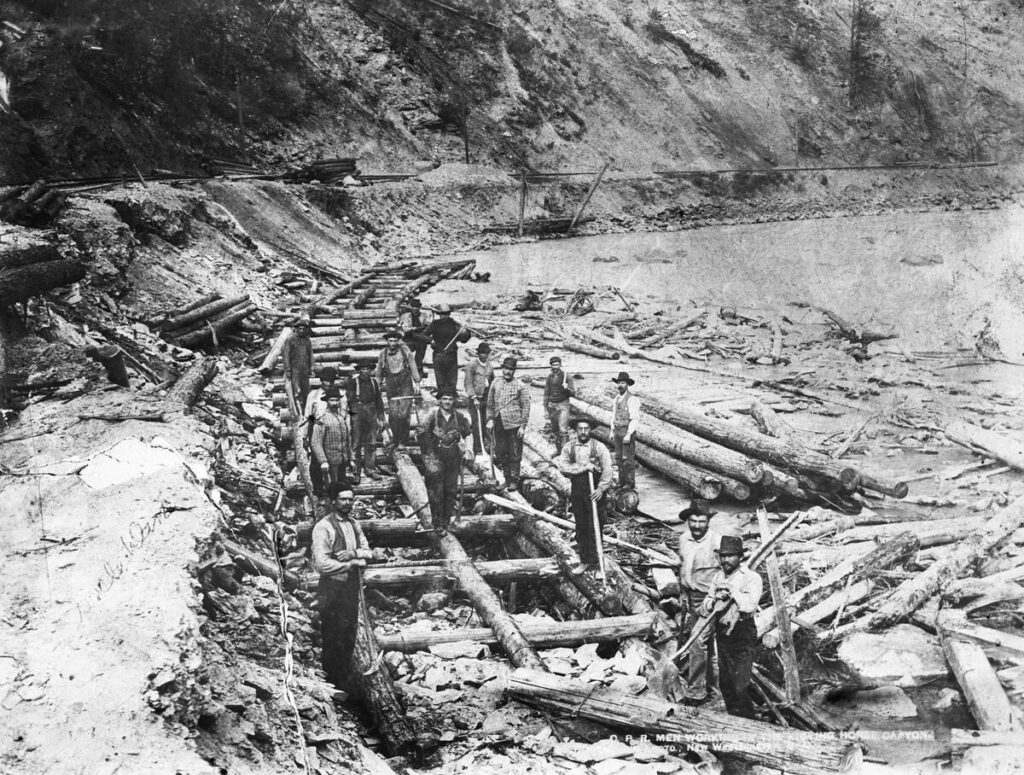
“As soon as the 5th crossing was completed, I moved camp to a point close to the tote-road several hundred feet above the road-bed of the railway, which kept close to the edge of the Kicking Horse.”
“By this time the camp had been enlarged by the addition of another tent to provide quarters for two pile inspectors, Dand, and Albro – a Halifax man – and two timekeepers: Haultain, and Martin. The duty of the pile inspectors was to see that the piles were according to specification and that they were driven to proper resistance. The timekeepers kept a record of the time taken in doing all extra work for which no specific price was provided in the contract. The contractor was paid for this on a cost-plus basis.”
The Tote Road and the Golden Stairs
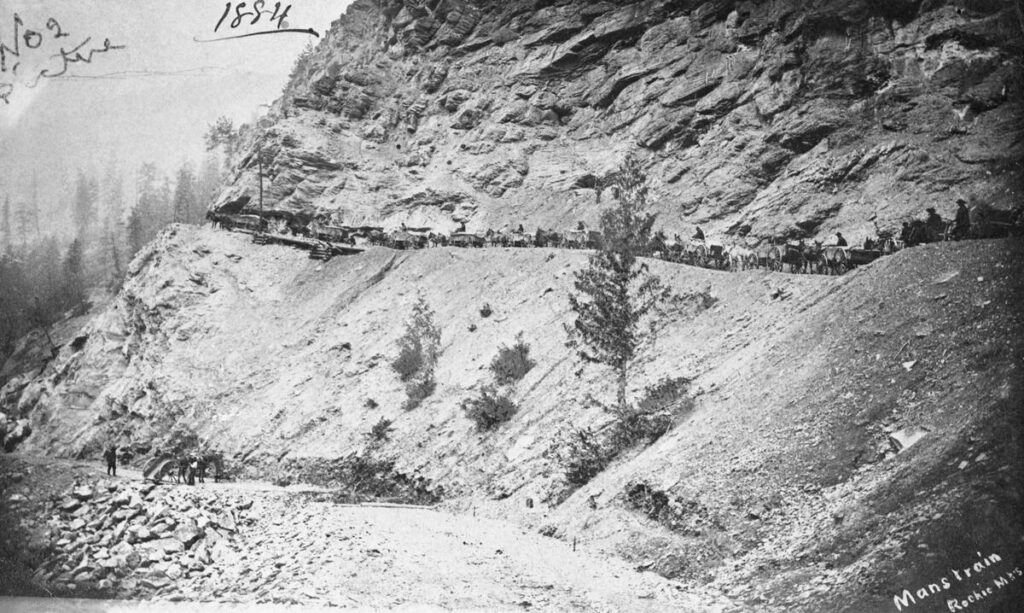
“The tote-road at this point followed closely along the route of the old pack trail known as the Golden Stairs, which the surveyors had used. In some places, it was just this pack trail widened to make it a wagon road. It would in and out along the face of the slope which tops the almost sheer cliff, at the foot of which the waters of the Kicking Horse tumble in rapids over rocks and boulders, on their way to swell the less turbulent waters of the Columbia.”
“The bridge at this crossing was at the mouth of a tunnel, known as Muir’s tunnel, built by Muir Brothers, the contractors. Our camp was almost directly above this tunnel – some hundreds of feet – so we had some fairly stiff climbs to make in connection with the bridge-building which we looked after from this camp. Besides the 6th crossing, there were a number of fairly large trestle and pile bridges, over tributaries of the Kicking Horse, between the 5th and 6th crossings. And we had also the 7th crossing, where the railway crossed back again to the right of the river.”
“It was somewhere in the vicinity of the 7th crossing that Holt had his contract. The material was, for the greater part, solid rock, and in part of this there was a tunnel.”
Moberly House
“My next move was to the Columbia valley, a short distance past Holt’s camp, in the vicinity of what is now the town of Golden. I have no distinct recollection of making this move, but clearly remember my first night in camp there. I missed the rhythmic sound of the tumbling waters of the Kicking Horse, to which I had unconsciously become accustomed; and the stillness of the Columbia was such a contrast that I had great difficulty in going to sleep that night.”
“Our camp was close to the log house in which Walter Moberly had spent a winter when employed by the government in making exploratory surveys for the railway. This house thus came to be known as the Moberly House.”
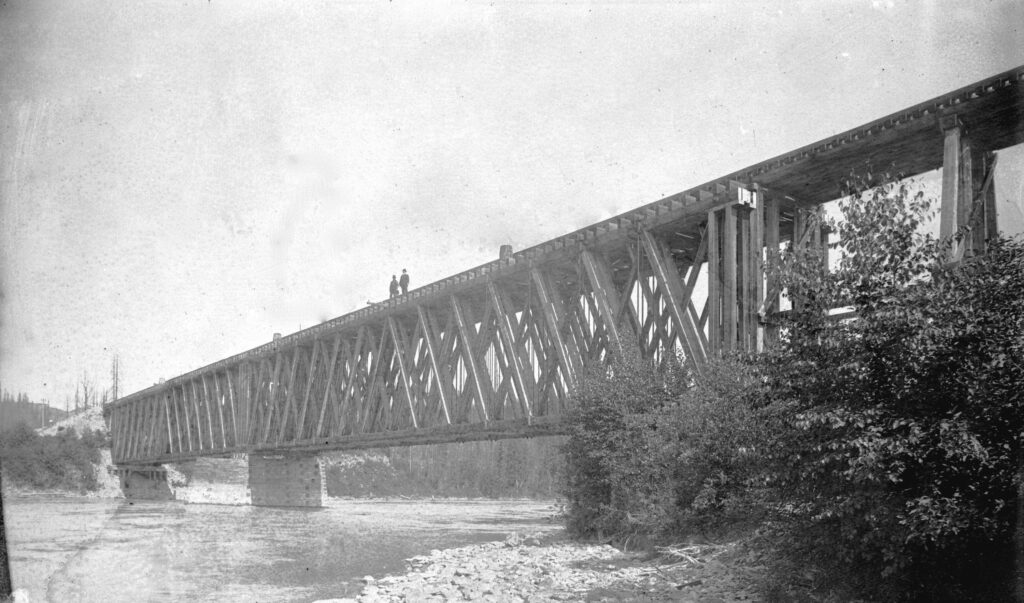
First Crossing of the Columbia River
“My next move was to the first crossing of the Columbia. About the same time construction headquarters were moved from Palliser to that vicinity too and formed the nucleus of the town which sprang up there – later known as Donald.
The bridge to be built across the Columbia was the principal one that engaged my attention at this camp. It was a two-truss bridge and the piles for the pier connecting these trusses were driven from a scow, which was attached to a cable stretched across the river.”

Date: July 13, 1899
Photographer/Studio: Heckman, Joseph W.
Quartz Creek
“There were quite a number of smaller bridges which I had to lay out from this camp. When these, and the bridge over the Columbia were completed, I moved camp to Quartz Creek, a tributary of the Columbia, a few miles from the mouth of the Beaver River.”
“When the time came to move camp from Quartz Creek, winter had definitely set in. Two teams with sleighs arrived at camp one evening and stayed the night to be ready to move the camp in the morning. It was a very cold night, and the temperature – according to current talk the next day – dropped to 40 degrees below zero.”

VPL Accession Number: 855
Date: July 13, 1899
Photographer / Studio: Heckman, Joseph W.
Beavermouth
“However we got the tent packed up somehow; we moved camp to a site on the left bank of the Beaver River a few miles from its mouth, that is to say, from its junction with the Columbia. This junction point later became known as Beavermouth.”
“We were camped here, however, only temporarily, pending the completion of a log house which was being built for us as winter quarters. After a week or two, the house was completed, and we moved into it a short time before the end of the year.”

VPL Accession Number: 851
Date: July 22, 1899
Photographer / Studio: Heckman, Joseph W.
Mountain Creek and Cedar Creek
“In the interval, I spent considerable time checking measurements at the sites of two large bridges – Mountain Creek, and Cedar Creek – and familiarizing myself with them, as the laying out and superintending the building of these bridges was to be my work for the winter.”
“On my section, in addition to the bridges over Mountain Creek and Cedar Creek, I had a number of smaller ones – including the one over the Beaver. Stoess had charge of the bridge over Surprise Creek and Swan the one over Stoney Creek, some 300 feet high – the highest of all.”
“Mountain Creek bridge was 1,200 feet long and 150 feet high. It was the largest of all the bridges in regard to the amount of timber required to build it. It consisted of a central span of 150 feet, flanked at each end by two smaller truss spans of 30 feet each; and by a number of trestles and pile bents 15 feet apart.”
“But it was quite a different story at Cedar Creek. Although this was a much smaller bridge – one span of 100 feet, and 100 feet high – the approaches were steep rocky cliffs. On one occasion Stuart and I were standing on a ledge clinging to the rope when a big chunk of hardened snow thundered down on top of us. It knocked us off our perch and sent us sliding down the rope at lightning speed to the ground below.
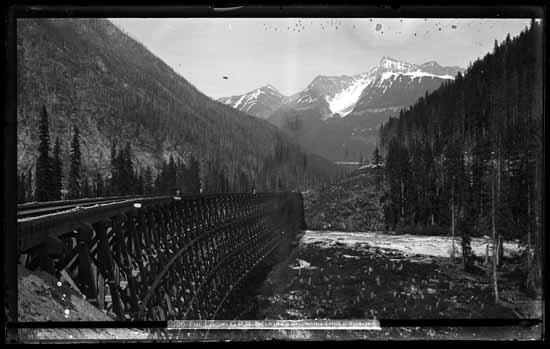
VPL Accession Number: 19993C
Date: 188-
Photographer / Studio: Bailey Bros.
The Loop
It was to the Loop that I made my next move. This move meant abandoning our comfortable log house, and, getting back into tents. But that didn’t trouble us in the least. It was all in our job.
“These five bridges – mostly fairly high trestles – comprised in this series of loops. One was near to Glacier over Glacier Creek, a tributary of Illicilliwaet. Two were over another tributary, Ross Creek; and two were over the Illicilliwaet. Most of these bridges were on curves.”
“My move this time was to Albert Canyon, so named, it was said, after Albert Rogers, a nephew of Major Rogers. He had been assistant to the Major in his exploratory surveys.”
“The railway, at a point near the Canyon, had to cross the Illicilliwaet again, on a fairly high truss bridge. It was decided, however, to first build a temporary pile bridge to be replaced by the truss later.”
To find more about P Turner Bone
It is at this point we leave Bone as his work takes him out of our area and into Farwell or Revelstoke as we call it today. You can find the complete text for this book here.
http://peel.library.ualberta.ca/bibliography/6914/112.html
